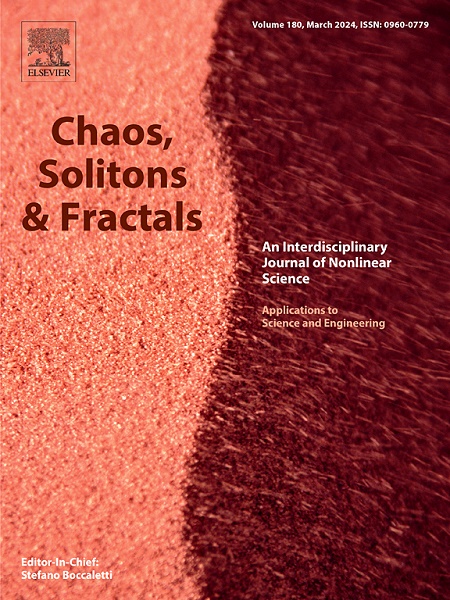Turbulent waves and oscillating amplitude of boundary-layers and radiative-heat transfer of nonlinear Williamson nanofluid over solar plate with periodic conditions
IF 5.3
1区 数学
Q1 MATHEMATICS, INTERDISCIPLINARY APPLICATIONS
引用次数: 0
Abstract
Turbulence and oscillating amplitude of boundary layers and nonlinear radiative heat and concentration motion of transient Williamson nanomaterial model alongside inclined solar surface with entropy optimization, magnetic oscillation, dynamic solar energy, and thermo diffusion is the novelty of this work. The objective of this problem is to scrutinize the speed streamlines, isothermal lines, energy/temperature and mass/concentration fields, steady heating ratio and instability of fluctuating energy/heat transfer alongside inclined plate at angle π/4. Governing mathematical formulation is developed to find the numerical outcomes of unknown physical properties. Fluctuating Stokes transformations and dimensionless variables are developed to reduce governing equations into oscillatory and steady equations with defined boundary values. Various pertinent parameters are generated for physical analysis of heat rate such as Eckert number (), buoyancy number (), oscillating magnetic parameter (), Schmidt number (), radiation number (), thermophoresis number (), Prandtl number (Pr), and Brownian motion number (). Primitive variable transformation is applied to generate symmetry in all governing equations in FORTRAN programming tool for accurate asymptotic results. Implicit formula of finite difference scheme with central and backward relation is used to convert system of equations into algebraic equations. The obtained algebraic equations are solved through Gaussian elimination technique to explore fluid flow, heat and mass rate, and periodical fluctuations in thermal and concentration gradients. It is perceived that high largeness in fluid speed and energy/temperature field is depicted as thermal radiating constraint upsurges. The magnitude of streamlines ad isothermal lines is decreased as oscillating magnetic number and Eckert number increases but isothermal lines increased with maximum strong magnetic field. High oscillations in turbulent behavior of fluctuating heat and concentration/mass removal is noted for each value of magnetic field and Weissenberg number.
周期性条件下太阳板上非线性Williamson纳米流体的湍流波、边界层振荡幅值和辐射换热
具有熵优化、磁振荡、动态太阳能和热扩散的瞬态Williamson纳米材料模型沿倾斜太阳表面的边界层湍流和振荡振幅以及非线性辐射热和浓度运动是本研究的新颖之处。该问题的目的是仔细检查速度流线,等温线,能量/温度和质量/浓度场,稳定加热比和波动能量/传热沿倾角π/4板的不稳定性。开发了控制数学公式来寻找未知物理性质的数值结果。利用波动Stokes变换和无量纲变量将控制方程简化为具有定义边值的振荡方程和定常方程。生成了用于热率物理分析的各种相关参数,如Eckert数(Ec)、浮力数(λT)、振荡磁参数(Mf)、施密特数(Sc)、辐射数(Rd)、热泳数(NT)、普朗特数(Pr)和布朗运动数(Nb)。在FORTRAN程序设计工具中,采用原始变量变换对所有控制方程进行对称生成,得到精确的渐近结果。利用中心向后关系有限差分格式的隐式公式将方程组转化为代数方程。通过高斯消去技术求解得到的代数方程,探索流体流动、热量和质量率以及热梯度和浓度梯度的周期性波动。可以认为,流体速度和能量/温度场的大尺寸被描述为热辐射约束上升浪。随着振荡磁数和Eckert数的增加,流线和等温线的大小减小,而等温线的大小随着最强磁场的增大而增大。对于磁场和Weissenberg数的每个值,湍流行为中的波动热和浓度/质量去除具有高振荡。
本文章由计算机程序翻译,如有差异,请以英文原文为准。
求助全文
约1分钟内获得全文
求助全文
来源期刊

Chaos Solitons & Fractals
物理-数学跨学科应用
CiteScore
13.20
自引率
10.30%
发文量
1087
审稿时长
9 months
期刊介绍:
Chaos, Solitons & Fractals strives to establish itself as a premier journal in the interdisciplinary realm of Nonlinear Science, Non-equilibrium, and Complex Phenomena. It welcomes submissions covering a broad spectrum of topics within this field, including dynamics, non-equilibrium processes in physics, chemistry, and geophysics, complex matter and networks, mathematical models, computational biology, applications to quantum and mesoscopic phenomena, fluctuations and random processes, self-organization, and social phenomena.
 求助内容:
求助内容: 应助结果提醒方式:
应助结果提醒方式:


